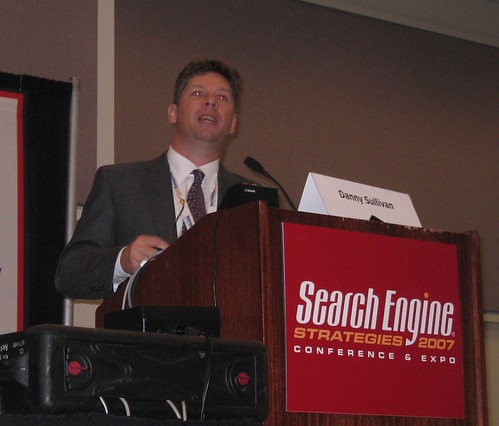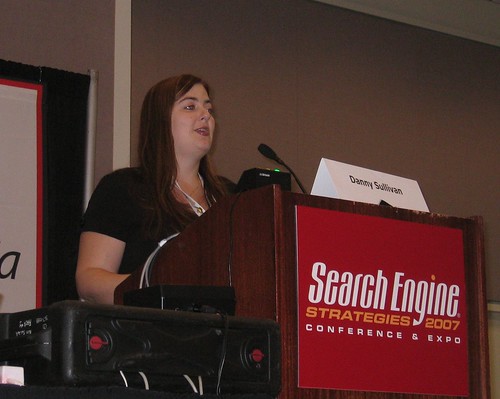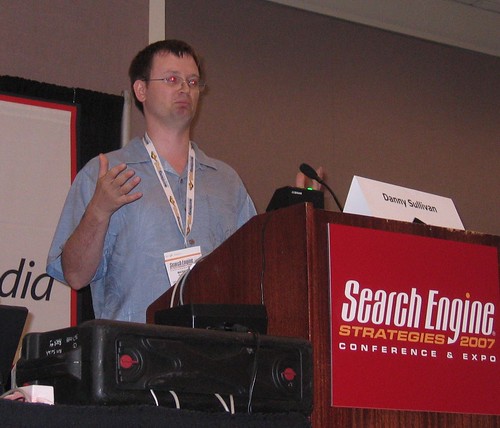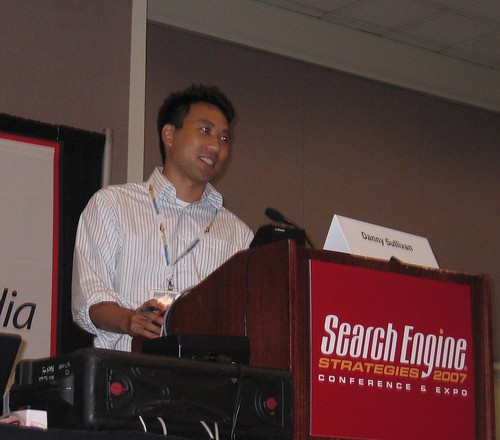This session looks at the way publishers can generate revenue by carrying contextual ads offered by major networks. Learn about some programs out there and tips on getting more from the ads you carry. Moderator:
* Danny Sullivan, Conference Co-Chair, Search Engine Strategies San Jose
Speakers:
* Jennifer Slegg, Owner, JenSense.com * Jeremy Schoemaker, Founder and CEO, Shoemoney Media Group Inc. * Bryan Vu, AdSense Associate Manager, Google * Markus Frind, Founder, Plentyoffish.com
Danny introduces Earning Money on Contextual Ads and he explains that Stephan Spencer's daughter, who was featured on BlogHer, is now making about $900/month by optimizing her Neopets blog. Tons of people are earning money off contextual ads and that's what this session is all about.
The first person who is up is Jennifer Slegg.
She is introducing her session on how to increase revenue, YPN and AdSense, CPA ads, how to protect your account, and what to do when you get suspended.
How to influence ads that appear: - Titles: make sure you have a really good title tag with good keywords - Metatags: It does influence AdSense even though it doesn't have much emphasis. - Alt tags in images - Proximity: make sure there are keywords around the ad units that influence the ads - Keyword hints: you can contact Google and ask for help to get you better relevant ads. - Stop words: it's not a huge issue like it used to be, but it's still an issue. If you have some words that trip the AdSense stopword filter, you're going to see PSA ads instead of real ads. Work around it.
Use image ads to your advantage: Enable image only ads on AdSense for an image-only secondary placement. - Avoid AdSense heaviness. - No PSAs. - CPM ads.
Using CTR to your monetary advantage: - The highest CTR should be first in HTML: highest earning; test with multiple channels. A beginner mistake is believing the hunit highest on the webpage is the first in HTML but that's not true.
Borders - we always talk about blending your borders. It's not always the best thing to do. It's a beginner's mistake to assume blended is best. Testable border styles: contrasting colors, complementary colors, blending colors, corners.
YPN: the "eternal" beta Some people get more money on YPN than AdSense so it's worth testing.
Drawing attention to your ads: - You can attract attention legally: add Sponsored Ads, Sponsored Links, etc. - Avoid compliancy issues - Don't blend - Case study: labelling ads as sponsored results increased CTR 1.5%
Using AdSense for Search: - You should enable AdSense for search. - Volume = $ - Display results on your own site - Offer a site search solution.
Switch it up: - Banner blindness is a bigger problem particularly in the last 12-18 months. - Therefore, do the following: ad rotation (OpenAds), color variety, style variety (custom channels - you can see which ad units people respond best to so you can make sitewide changes to increase revenue)
CPA referral ads: you get paid only when there's a conversion. The problem with is that people choose ads that are not super targeted (e.g. putting a mortgage ad on a hockey website). People are going overboard.
Think about the links: think about the words that lead to that page. If you're linking to an article on your page, make sure you have good keywords. Don't use "click here." Similarly, this is an ad influencer and will help you get more relevant ads.
Remove the excess: everything can influence ads, such as JavaScript & CSS. Link to those in external files. Use section targeting.
For your ad titles, optimize your ad title colors for higher CTR. The best possible title link is hyperlink blue or the slightly lighter version of the hyperlink blue. If your color scheme is red, then use red text.
Smart filtering: - Use your filter list with caution: if you block ads, lower paying ads appear instead. Thus, only filter (1) competitors, (2) grossly mistargeted advertisers, (3) ads that are not appropriate for your audience. One ad unit versus three: Very important to know that you can have one ad unit on a page and make more money than if you had three on a page. - More is not always better. - Beginner's mistake: we've all been to those web pages where you see 3 ad units, 3 ad links, 3 referral links, 2 search boxes, etc. Don't overload. Give them a good user experience. - Case study: overall page revenue site-wide increased 30% when 3 ad units were replaced with one.
AdSense on Forums - the big problem is that CTR is low. Change up the color schemes, colors, styles, borders. Enable image ads (they do phenomenally ads on forums compared to elsewhere). Do whatever you can to attract CPM advertisers. You can also bombard guest users with advertising and not so much with your registered users.
Blogging with AdSense: - Use YPN RSS ads - Use section targeting - Blog terms in images - Dynamic content solution: use ads on individual entries only. Non-content sites: - Image and flash-heavy sites: put on-page text there, edit alt tags, meta tags, and image tags.
Protecting your AdSense accounts: what can you do to insure that nothing negative happens to your account? Get a non-associated login ID. Unsecure connection: Don't go into a web cafe and look at your stats. Check your raw logs. Use an ad tracker. Policy changes. AdSense is known to change their policies on occasion and they can be significant changes, so keep up to date. Email whitelist & reverse IP lookup. Add google.com to your whitelist. On the flipside, people can get emails with masked headers, so do reverse IP lookup on those.
If your account is suspended: - Compliance issue: you have 3 days to fix the problem. - When you do get a warning, sometimes they'll stop ad serving on a single page, an entire site, or an entire account. However, you can still log into your account. - Once you fix the problem, they will hopefully reinstate your account, but it depends (if it's not quality, you're out of luck) - Warning vs. suspension: different offenses have different punishments (sometimes 3 strikes, you're out) - Avoid bad traffic sources, avoid inciting clicks, follow the YPN/AdSense policy terms, don't blab your stats or blog about secret beta tests, and never click on your own ad. - YPN has a compliancy manager: so it will appear there. - Get a look at your logs. - Make a list of all the sites you're running ads on and send them to Google and ask if these ads are being running on other pages (by using your ID). - Competitor issues - have you riled up a competitor and they're trying to suspend your account? - When you formally appeal your suspension, if you think you know what you did, tell them. It's better to come clean. Be polite.
Next up is Jeremy Schoemaker aka Shoemoney.
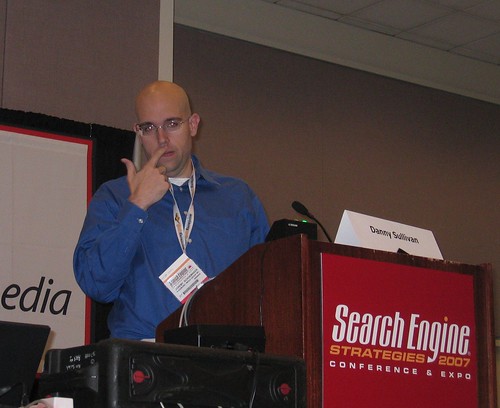 (Caption: Shoemoney illustrating that he was rushing to get ready for the event since his luggage was lost. I think he accidentally cut his face with a razorblade or something.)
(Caption: Shoemoney illustrating that he was rushing to get ready for the event since his luggage was lost. I think he accidentally cut his face with a razorblade or something.)
He talks about how he gets started making money on contextual advertising. He's always been interested in creating free services that he'd share with other people.
His service was a mobile service that people used to share pictures and one with ringtones as well. He then had a revelation at a bank when someone asked how Google was making money. In March 2004, he started running a contextual product, and was making $4/day. This passive income got quite interesting for him. He read a bunch of ebooks and DigitalPoint forums and implemented a bunch of ideas. Within six months, he was making thousands of dollars a day.
When you start using contextual advertising: aim for complete functionality. You don't want to try to make money on a site that doesn't work. Making money is a job in itself. Also, try to have thousands of users a day (1000+ uniques a day).
The positives to contextual advertising -- and the #1 thing -- is how easy it is. Cut and paste code and you're making money. It's very simple. The other thing is that with traditional advertising, you used to seek out advertising. You don't need to do this anymore.
The negatives to contextual advertising is the lack of editorial control. You can block your competitors as Jen showed, but competitors can put ads on your page that give a bad experience. As Matt Cutts once said, the ads on your website reflect your intent, so you don't want to show them something that you don't approve of.
The other negative is that in order to make money, people need to leave your site. But if your goal is to build a subscription, you don't want them to leave. You want to retain your users.
You need to be careful about people who are gullible and click on an advertisement on your site and end up being charged money. It's not your ad, but they think that you're backing it. Be careful.
The Gray Area: legal vs. illegal (and everything -- a huge gap -- in between). The gray area is so new and so many people are doing innovative/creative things that are not within good or bad, and that's where you can find Shoemoney.
The difference between innovative and about-to-be-banned is communication. Therefore, ask Google or Yahoo about a new idea. If Google/Yahoo gives you a canned response, it's not exactly a "no," is it? (The audience laughs.)
Once, people put images right above your ads. It's no longer allowed. This is clearly defined in the policies now.
Contextua Arbitrage aka Search Engine Arbitrage: this is the biggest gray area now. This is when people buy traffic from Microsoft and create a page for Google AdSense and make money from it.
Example: BearShare. It's a P2P network. When you install it, it offers to set it up as your start page - you have no choice - you can either Decline or Accept. The homepage is google.bearshare.com, so it's getting a huge amount (94%) of traffic. But it turns out that after he asked Google, they found out that the AdSense code was modified and was against their policies. Worse, if you uninstall BearShare, it keeps coming back.
Are people really getting banned? Definitely. Check DigitalPoint forums to see. Let Google know and they'll be receptive.
YPN's growing pains: Yahoo is kind of in a disaster right now. They're in beta for 2 years now (August 2005). It was unstable and unreliable. There's horrible targeting. It was too focused on advertisers and not publishers, and there are false alarm compliance issues. He shows some very-off-topic advertisements (RV diesel fuel on a ringtone page? Refinance bad credit on an American Idol site? What?)
Tools for Contextual Advertising: - CrazyEgg heatmap - Google Analytics - OpenAds (www.openads.org): tracks your ads, offer delivery limitations
Know your CPC: the most important with contextual product because you have the one-click-and-gone effect. The most money you can make from that click, the better.
Tips for success: test everything, don't sell out, use an ad server, apply analytics and heat maps, and COMMUNICATE.
The third speaker is Markus Frind of PlentyofFish.com.
He often hears: will I make money from contextual ads, and does it work? Well, he made $10+ million so far. At first, he was making $30/day to start.
Visitors won't come back with banner ads, he says. Your site looks like crap and visitors don't want to deal with it. You want people to come again and again so they can click on ads.
Really, to grow, never put more than one banner ad on a page. If you do, you won't get very far.
When he started, he only had ads on 30% of his pages. Gradually, they've been added to 70% of the pages. It's important for people to come over and over.
The first impression is worth 5-10x as much as the average. It's really important to isolate your impression - frequency capping. If you can shift ad impressions to an ad network or a customized ad center where people can bid on your ads.
Some pages have different CTR: it's important to have advertisers bid on these certain channels.
You want to break out countries. For instance, AdSense may make you $2-3 a day and YPN makes $1 a day. That doesn't mean that AdSense is better than YPN. Break out your visitors.
If you have a site where people can log in, break out users by age/ethnicity. It's a smart pricing problem. Certain segments of users wouldn't buy or convert when they clicked. But by breaking to age, you can create separate channels - different CTRs for different age groups increases revenue 40-50%.
If you're going to use AdSense for search, you want to put it on Logout pages - right where they want to exit.
In the future, everyone is going to based on demographics. Things will be changing in the next 12 months.
The final speaker is Bryan Vu from Google AdSense. He adds that Googlers who click on ads from google.com domains don't charge advertisers.
Branding: some of the newer things Google launched are Flash ads, click-to-play videos, and newer formats. Google is also releasing gadget ads - interactive branding mechanisms - they're working to find the best models for advertisers to get their messages across. Google is working to invest in video content monetization.
Another main theme for this year is making advertiser performance work well: e.g. placement performance reports for advertisers to optimize their campaigns. Targeting to demographics (placements for publishers). One of the things publishers can do is create a specific channel (e.g. African American Female channel) and it will show up for those users. You can do the same thing for age breakdowns. They're working on these controls and are hoping to maximize on its effectiveness.
They also want to offer more education about the content network. Content vs. search networks are very different and they want to focus on content.
The last theme for the AdSense team is a large set of new products, such as monetization of feeds (Feedburner's acquisition comes into mind). Google is also doing content syndication with the creator of the Family Guy and American Dad. Google is also integrating the AdSense API so that it is compatible with blog platforms, etc. There's also AdSense for Mobile and the ability to monetize on that.

